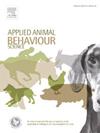美国南加州杀鼠饵站附近屋顶共生大鼠的行为和活动
IF 2.2
2区 农林科学
Q1 AGRICULTURE, DAIRY & ANIMAL SCIENCE
引用次数: 0
摘要
屋顶鼠(Rattus Rattus)是一种高度入侵的老鼠,对人类和本地物种构成威胁。在城市环境中,它们通常使用含有化学灭鼠剂的诱饵站进行管理,然而,它们在诱饵站周围的行为尚未得到很好的了解。我们在加利福尼亚州橙县的36个住宅院子进行了实地研究,以确定不同的诱饵站设计或诱饵方法是否会影响站点周围屋顶老鼠的行为。具体来说,我们在三个单独的试验中测试了诱饵站的设计、补充诱饵的存在以及在诱饵站添加气味诱饵是否会影响老鼠的行为。在每次试验中,我们使用数字游戏摄像机对含有无毒诱饵的站点进行为期三周的监测,以估计发现、进入、诱饵消耗和站点周围老鼠夜间活动的时间。我们还确定了与每个院子相关的景观特征(啮齿动物管理、宠物/牲畜或水果/蔬菜的存在)是否影响老鼠的行为。大多数院子(75 ~ 91 %)有鼠出没,大多数院子有鼠站(59 ~ 89 %)。然而,他们没有进入很多站点(24 - 63 %站点进入)。车站的设计和在车站添加气味诱饵都没有影响任何测量的响应变量。在两种类型的站点中,站点周围补充饵料减少了大鼠的进入时间,增加了夜间活动,并增加了所有站点的饵料消耗。院子里水果和蔬菜的存在减少了发现车站的时间,但不影响任何其他响应变量。目前或最近(过去六个月内)管理啮齿动物的院子里的老鼠与未管理的院子里的老鼠一样活跃,但不太可能消耗诱饵,这表明新恐惧症不是导致诱饵回避的唯一因素-以前接触管理也可能导致共生老鼠回避诱饵。这强调了可能需要使用现有工具来有效控制共生大鼠的新方法。本文章由计算机程序翻译,如有差异,请以英文原文为准。
Behavior and activity of commensal roof rats around rodenticide bait stations in southern California, USA
The roof rat (Rattus rattus) is a highly invasive rat that poses a threat to humans and native species. In urban settings they are typically managed with bait stations containing chemical rodenticides, however, their behavior around bait stations is not well understood. We conducted field studies in 36 residential yards in Orange County, California, to determine whether different bait station designs or baiting approaches influence roof rat behavior around stations. Specifically, we tested whether the bait station’s design, the presence of supplemental bait, and the addition of a scent lure in the station influenced rat behavior over three separate trials. Using digital game cameras, we monitored stations containing non-toxic bait for three weeks during each trial to estimate the time to discovery, entry, bait consumption, and nightly activity of rats around stations. We also determined whether landscape characteristics associated with each yard (presence of rodent management, pets/livestock, or fruits/vegetables) influenced rat behavior. Rats were detected in most yards (75 – 91 % of yards), and they discovered stations in most of these yards (59 – 89 % stations discovered). However, they did not enter many stations (24 – 63 % stations entered). Neither the station’s design nor the addition of a scent lure in the station affected any of the measured response variables. Supplemental bait around stations decreased the time to entry and increased the nightly activity of rats at two types of stations, and increased bait consumption in all station designs. The presence of fruits and vegetables in the yard decreased the time to discovery of stations, but did not affect any other response variables. Rats in yards that were currently or recently (within last six months) managed for rodents were just as active as in unmanaged yards but were less likely to consume bait, indicating that neophobia is not the only factor contributing to bait avoidance -- previous exposure to management may also lead to bait avoidance by commensal rats. This underscores that new approaches may be needed to effectively control commensal rats with the tools currently available.
求助全文
通过发布文献求助,成功后即可免费获取论文全文。
去求助
来源期刊

Applied Animal Behaviour Science
农林科学-行为科学
CiteScore
4.40
自引率
21.70%
发文量
191
审稿时长
18.1 weeks
期刊介绍:
This journal publishes relevant information on the behaviour of domesticated and utilized animals.
Topics covered include:
-Behaviour of farm, zoo and laboratory animals in relation to animal management and welfare
-Behaviour of companion animals in relation to behavioural problems, for example, in relation to the training of dogs for different purposes, in relation to behavioural problems
-Studies of the behaviour of wild animals when these studies are relevant from an applied perspective, for example in relation to wildlife management, pest management or nature conservation
-Methodological studies within relevant fields
The principal subjects are farm, companion and laboratory animals, including, of course, poultry. The journal also deals with the following animal subjects:
-Those involved in any farming system, e.g. deer, rabbits and fur-bearing animals
-Those in ANY form of confinement, e.g. zoos, safari parks and other forms of display
-Feral animals, and any animal species which impinge on farming operations, e.g. as causes of loss or damage
-Species used for hunting, recreation etc. may also be considered as acceptable subjects in some instances
-Laboratory animals, if the material relates to their behavioural requirements
 求助内容:
求助内容: 应助结果提醒方式:
应助结果提醒方式:


